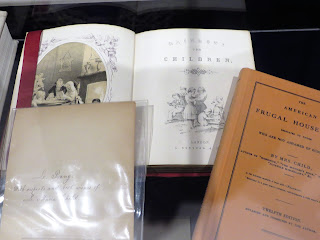Women's History MonthLydia Maria Child
Part II
Lydia Maria (Francis) Child 1802-1880
In 1831, William Lloyd Garrison, an abolitionist from Boston, started publishing a newspaper called The Liberator. Maria read it and became a reformer. She joined the Boston Female Anti-Slavery Society. She wrote anti-slavery papers after that. In 1833 she published
An Appeal in Favor of that Class of Americans Called Africans. It made her very unpopular. She had to shut down her children's paper.
That did not stop her writing about slavery. Her next job was editor of the National Anti-Slavery Standard, a New York paper from 1841-1843. She was upset by the Compromise of 1850 and offered her support to John Brown for his raid at Harper's Ferry. (He didn't want it).
During the Civil War she collected supplies for "contraband" (runaway slaves attached to the Union Army). She wrote a reading book for newly freed slaves called Freedmen's Book. The book had biographies of black leaders, stories of fugitive slaves and practical advice. Maria published it mostly with her own money. The book was sold cheaply so freedmen could afford it. All profits were went into future editions. Maria edited Incidents in the Life of a Slave Girl by Linda Brent (Harriet Jacobs) and helped get it published.
After the Civil War Lydia supported women's suffrage but she thought black men should have the right to vote first. She founded the Massachusetts Woman Suffrage Association. She also continued to support Native Americans. She thought they had the right to keep their own language and religion.
Maria's husband died in 1874. She finally had money of her own and donated it to support her personal causes. Maria continued to write and support charities until she died in 1880. She was very, very famous in her day and had many famous friends and fans like Edgar Allen Poe, Elizabeth Cady Stanton, Lucretia Mott and the Alcotts. In your day she is mostly remembered for "Over the River and Through the Woods."
An Appeal in Favor of that Class of Americans Called Africans. It made her very unpopular. She had to shut down her children's paper.
That did not stop her writing about slavery. Her next job was editor of the National Anti-Slavery Standard, a New York paper from 1841-1843. She was upset by the Compromise of 1850 and offered her support to John Brown for his raid at Harper's Ferry. (He didn't want it).
During the Civil War she collected supplies for "contraband" (runaway slaves attached to the Union Army). She wrote a reading book for newly freed slaves called Freedmen's Book. The book had biographies of black leaders, stories of fugitive slaves and practical advice. Maria published it mostly with her own money. The book was sold cheaply so freedmen could afford it. All profits were went into future editions. Maria edited Incidents in the Life of a Slave Girl by Linda Brent (Harriet Jacobs) and helped get it published.
After the Civil War Lydia supported women's suffrage but she thought black men should have the right to vote first. She founded the Massachusetts Woman Suffrage Association. She also continued to support Native Americans. She thought they had the right to keep their own language and religion.
Maria's husband died in 1874. She finally had money of her own and donated it to support her personal causes. Maria continued to write and support charities until she died in 1880. She was very, very famous in her day and had many famous friends and fans like Edgar Allen Poe, Elizabeth Cady Stanton, Lucretia Mott and the Alcotts. In your day she is mostly remembered for "Over the River and Through the Woods."













